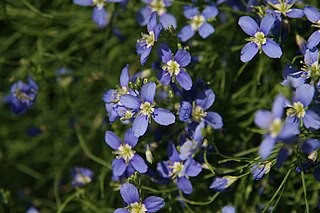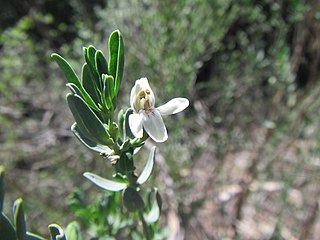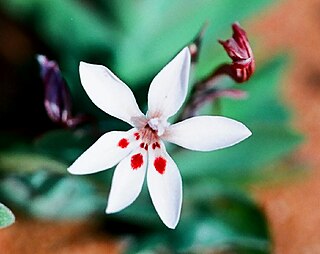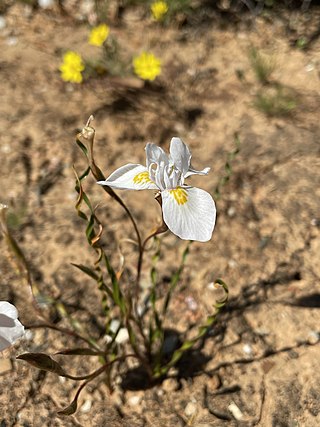
Jasmine is a genus of shrubs and vines in the olive family of Oleaceae. It contains around 200 species native to tropical and warm temperate regions of Eurasia, Africa, and Oceania. Jasmines are widely cultivated for the characteristic fragrance of their flowers. Additionally a number of unrelated species of plants or flowers contain the word "jasmine" in their common names.

Drosanthemum floribundum, commonly known as rodondo creeper, pale dewplant, or dew-flower, is a succulent plant in the ice plant family, Aizoaceae. The species is native to the Eastern Cape in South Africa and is naturalised in Portugal and the states of South Australia, Western Australia, and Victoria in Australia, as well as Pacific Grove, California where it is called the Magic Carpet. It is a trailing perennial with hairy stems and leaves that are either cylindrical or triangular in cross section. These are between 3 and 15 mm in length and 1 to 2.5 mm in width. Flowers are up to 2.5 cm in diameter and are lavender, pink or occasionally white.

Drosanthemum lavisii is a succulent plant in the ice plant family, Aizoaceae, indigenous to the Overberg region of the Western Cape Province, South Africa.

Drosanthemum hispidum, the hairy dewflower, is a species of perennial herb in the family Aizoaceae. They are succulent plants and have a self-supporting growth form and simple, broad leaves. Flowers are visited by Colletes schultzei.
Strumaria discifera is a species of flowering plant in the family Amaryllidaceae, native to west and south-west Cape Provinces. It was first described in 1992.

Strumaria gemmata is a species of flowering plant in the family Amaryllidaceae, native to the Cape Provinces and the Free State of South Africa. It was first described by John Bellenden Ker Gawler in 1814.

Strumaria truncata is a species of flowering plant in the family Amaryllidaceae, native to the Cape Provinces of South Africa. It is widely distributed in the northwest of the Cape Provinces, and the most common of the Strumaria species found there. It forms small clumps of bulbs which produce twisted leaves. Its flowers, which are pendulous, vary in colour from white to deep pink. The pink forms were once treated as a separate species, Strumaria rubella, and have also been called var. rubella. The species was first described by Nikolaus Joseph von Jacquin in 1792.

Hemimeris sabulosa is a species of flowering plant in the figwort family. It is endemic to the Cape Provinces of South Africa.

Crassula umbella is a succulent plant species in the genus Crassula. It is endemic to the Cape Provinces of South Africa.
Adromischus subviridis is a succulent plant species in the genus Adromischus. It is endemic to the Succulent Karoo of Northern Cape of South Africa.

Stachys rugosa is a species of perennial herb in the genus Stachys.

Lebeckia plukenetiana is a species of flowering plant in the genus Lebeckia. It is endemic to the Western Cape of South Africa.

Wachendorfia multiflora is a species of herbaceous plant in the genus Wachendorfia. It is endemic to the Western Cape. It also known as the Kleinrooikanol in Afrikaans.

Heliophila coronopifolia is a species of flowering plant in the genus Heliophila. It is native to the Northern Cape and Western Cape provinces of South Africa.

Justicia cuneata is a species of shrub in the genus Justicia. It is endemic to the Cape Provinces of South Africa.

Lapeirousia arenicola is a species of flowering plant in the genus Lapeirousia. It is endemic to the Northern Cape and Western Cape of South Africa.

Moraea serpentina is a flowering plant species in the genus Moraea. It is endemic to the Northern Cape and Western Cape of South Africa.
Quaqua incarnata is a species of succulent plant in the genus Quaqua. It is endemic to southwestern Namibia and to the Namaqualand region in the western Cape Provinces of South Africa.

Roepera morgsana is a succulent plant species in the genus Roepera. It is endemic to Namibia and the Cape Provinces of South Africa.

Polhillia ignota is a species of flowering plant in the genus Polhillia. Prior to its rediscovery in September 2016, it was known from two specimens, and declared extinct in 2014. There are only 13 plants known, on a small renosterveld fragment less than 3 ha in size. It is endemic to Eendekuil, in the Western Cape.


















